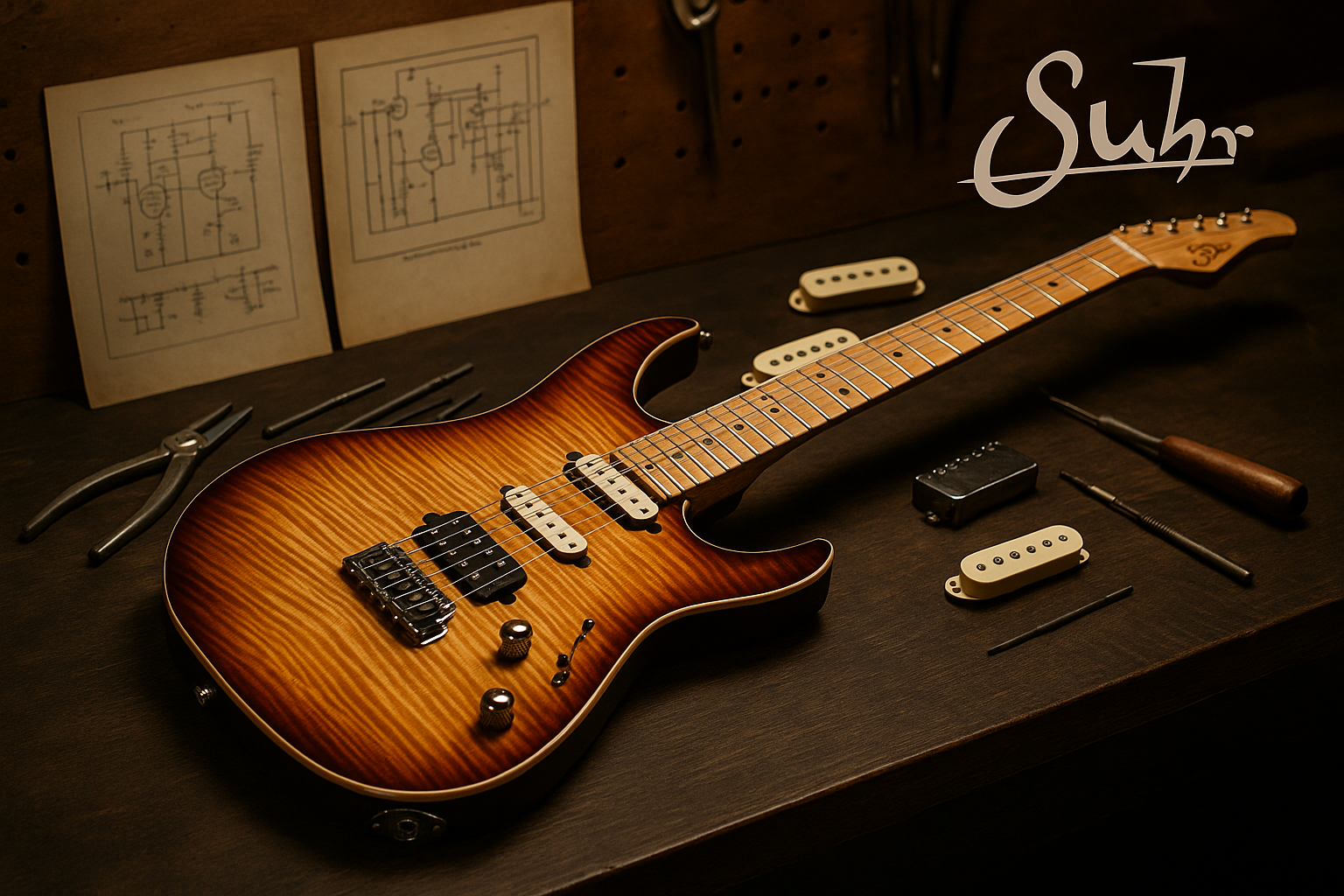When you see a Suhr guitar in the hands of a player, what often strikes you is not just how polished it looks, but how “right” it feels — the ergonomics, the balance, the tone — and that sense is no accident. The story behind Suhr Guitars is a tale of one luthier’s perfectionism, technical curiosity, and willingness to blend old‑school craft with modern innovation.
John Suhr: Early Years and the Path to Guitar Building
John Suhr’s path into guitar building was not instantaneous fame, but a gradual process fueled by playing, tinkering, and repairing. In an oral history interview, Suhr notes that while working as a repairman at Rudy’s Guitar Shop in New York City, he was already formulating ideas about modifying and designing instruments.
-
Suhr began building guitars in the 1970s.
-
His initial builds and experiments grew in parallel with his repair work — learning what was broken, how parts work, where improvements might lie.
-
By the early 1980s, Suhr was collaborating with Rudy Pensa under the Pensa‑Suhr name, producing high-performance guitars that combined features from Stratocaster-style designs with custom tweaks.
-
One of the most famous outcomes from that era is the Pensa‑Suhr model made for Mark Knopfler, designed to give hybrid tonal flexibility (blending strat and humbucker tones) so Knopfler could more easily shift sounds on stage.
That early work with Pensa gave Suhr credibility, but it was only the start.
In 1991, Suhr relocated to California and began working with amp and rig designer Bob Bradshaw. The two collaborated on designs such as the Custom Audio Electronics (CAE) 3+ preamp and the CAA OD‑100 amplifier — designs that harked to Suhr’s interest in electronics as well as guitars.
Then, in the mid-1990s, Suhr took a position at Fender’s Custom Shop as a Senior Master Builder, where he further honed his design, process, and product development skills.
By 1997, Suhr — joined by Steve Smith (who brought skills in management, software, and CNC programming) — launched JS Technologies, Inc. (Suhr Guitars), giving him full control over guitar design, parts, and finishing workflows.
The Evolution of Suhr Guitars and Brand Expansion
Early Years and Branding
From its founding in 1997, Suhr Guitars positioned itself as a high-end custom shop, building instruments to the exacting specifications of customers. Their philosophy: take all the lessons from repair, customisation, electronics, finish, and ergonomics, and bring them under one roof with modern tools like CNC routers to ensure consistency and precision.
In their early years, Suhr rolled out new models slowly — often one per year — emphasising tone, feel, and finish rather than high volume.
Product Diversification: Guitars, Amps, Pickups & Pedals
Over time, Suhr expanded beyond guitars:
-
Amplifiers & Preamps: The revival of the OD‑100 under the CAA brand and development of the Badger lineup of tube amps expanded Suhr’s reach into the amplification side of the rig.
-
Electronics & Pickups: Suhr developed its own in-house pickups and circuits (for example, noiseless single-coil systems) to complement their instrument designs.
-
Effects & Switching Gear: Over time, Suhr expanded to pedals, analog effects, and routing gear to give players a more integrated solution across the entire signal chain.
-
Affordability Tiers / Series: In 2010, Suhr introduced the Rasmus line (manufactured overseas, final setup done at Suhr) to reach a lower price tier. That line was later discontinued. Meanwhile, the Modern Satin series (produced in the main factory in California) was developed as a more streamlined, mid-tier product option.
Signature & Limited Edition Models
Suhr occasionally taps into its history to produce commemorative or “legacy” models. For example, in 2021–22 they released a Standard Legacy limited edition, modeled after the first guitar John Suhr ever built back in 1984.
They also engage with artists for signature models, giving players more direct input into specs, electronics, and ergonomics.
What Makes a Suhr—“Suhr”
One of Suhr’s distinguishing philosophies is that the “mojo” or magic in a guitar is not mystical but something you can control, refine, and reproduce. As one retrospective put it, although the instruments evoke the feel of classic guitars, Suhr believes that tone and response are quantifiable and can be engineered to be consistent.
Key characteristics often cited in Suhr guitars:
-
Ergonomics and playability – rolled fretboard edges, smooth neck contours, well-balanced bodies
-
Precision and consistency – use of CNC, tight tolerances, quality control
-
Modern electronics – noiseless coil options, push/pull circuits, high-output humbuckers, etc.
-
Custom options – wood choices, finishes, neck profiles, inlays, fret materials
-
Holistic design – the instrument, electronics, and rig (amp, effects) considered as a unified system
Over time, Suhr has earned a reputation not just as a boutique guitar maker, but as a boutique system maker: instruments and signal path tools intended to complement one another.
Notable Players Who Have Used Suhr Guitars
Throughout its history, Suhr has attracted a number of respected players who have used or endorsed their instruments. Here are some of the more well-known names and contributions:
|
Artist |
Notes / Relationship with Suhr |
|---|---|
|
Scott Henderson |
A long-standing Suhr client from the Fender Custom Shop days; Suhr built guitars and pickups for him. |
|
Mike Landau |
As a high-end session and tone-centric player, Landau has had custom Suhr instruments. |
|
Reb Beach |
Known for high‑gain rock and fusion work, Reb Beach is one of the artists listed by Suhr. |
|
Ben Harper |
Though not always associated with the most “shreddy” gear, Harper is among Suhr’s roster. |
|
Mateus Asato |
A social media–savvy virtuoso, known for expressive, dynamic playing, often seen with Suhr instruments. |
|
Mark Knopfler |
While more linked to the Pensa‑Suhr era, Knopfler’s use of the Pensa‑Suhr “hybrid” model remains part of Suhr’s legacy. |
|
Guthrie Govan |
For a period, Govan used Suhr guitars (signature models, custom Standards, Moderns, etc.). |
|
Ian Thornley, Dave Kilminster, Pino Daniele |
Also names associated with Suhr in artist rosters. |
While not every artist maintains a permanent Suhr endorsement (artists evolve, contracts change, gear choices shift), these associations help signal the pedigree and appeal of the brand among discerning players.
Legacy, Challenges & Outlook
By the 2010s, Suhr had already built a reputation as one of the top boutique guitar makers. But growth in the boutique market often brings challenges: balancing custom shop exclusivity with scalability, managing costs, and navigating competition from high-end production makers or boutique startups.
Some of Suhr’s smart moves:
-
Embracing modern tooling (CNC) to hold tolerances and consistency while retaining handcrafted finishing.
-
Expanding into complementary domains (amps, pedals, pickups) so that Suhr gear can “speak” well across the entire signal chain.
-
Offering different levels of instruments (e.g. “pro” or “satin” lines) to make certain models more accessible.
-
Continuing limited edition or legacy models that tie back to John Suhr’s earliest work, strengthening the narrative and heritage.
Looking ahead, the brand’s challenge will be continuing to innovate without diluting identity. Guitar players often crave both tradition and forward thinking — and in a crowded boutique space, the ability to integrate electronics, ergonomics, and aesthetic distinctiveness will matter.









